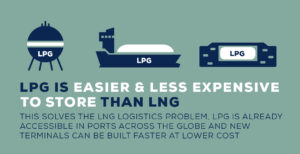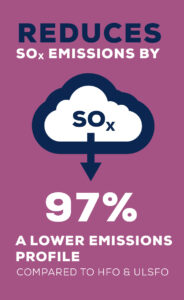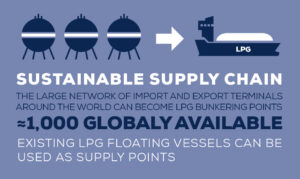LPG on Course to Help Decarbonise Shipping By James Rockall, CEO & Managing Director, WLPGA

It is indisputable that CO2 emissions are causing irreparable damage to our climate. 2022 has seen record temperatures across the world and stark warnings from scientists and NGOs that we need to change our behaviour if we are to avoid catastrophic long-term impacts to our planet. Global emissions cover almost every aspect of economic activity, which makes addressing them daunting, given the challenging economic climate. Certainly, at a time of high energy prices and supply insecurity, adding cost and uncertainty does not find favour in board rooms or with many governments. Yet there are cost-effective solutions that can, and should be embraced now. Addressing emissions in global shipping is one such area, and LPG is a leading contender to make a difference.
Nearly 90% of global freight is transported by sea, making it an essential part of all major supply chains. Although transport by ship is by far the most energy-efficient form of freight transport, the International Maritime Organization (IMO) estimates that shipping accounts for about 3% of global greenhouse gas emissions – approximately the same as the global aviation industry. The world’s fleet is split almost equally between ships for transport (60,000) and non-transport (50,000) covering service vessels, tugs yachts etc. and most of these vessels, whether large or small, use either heavy fuel oil (HFO) or diesel fuel. There are many pathways to lowering shipping emissions, including operational, ship design and fuel choice. As a fuel, LPG is a unique, exceptional energy and when it comes to decarbonising shipping, LPG has an important and growing role to play.
Transported and stored as a liquid, but consumed as a gas, LPG can deliver cleaner, lower emission marine transport than many alternatives currently available. As an example, compared to HFO, LPG demonstrates a reduction in CO2 of between 18% and 25%. But the LPG advantage doesn’t stop there. For businesses that are focused on both emissions reductions and economic competitiveness, LPG has much to offer. According to the National Korean Maritime & Ocean University, a conversion to LPG can also deliver over 25% reduction in fuel costs while presenting far lower capex investment than many other alternative fuels. BW LPG, a leading shipping company, estimates that output efficiencies can be improved by some 11% with LPG, allowing for cleaner engines and cheaper maintenance.
These benefits are already recognised with LPG being one of the most commonly accepted alternative fuel in the world today. Orders for LPG-fuelled ships have recently hit record levels, with 130 Very Large Gas Carriers (VLGCs) either on order or currently sailing on LPG; and it is anticipated that over 90% of new VLGCs that enter the market in the coming years will be capable of running on LPG. Although LPG is now a popular fuel for large gas carriers, this segment accounts for only 8% of shipping emissions, leaving a massive 92% from other types of vessels. The conversion of these ships represents a great opportunity to reduce global emissions even further.
The highest contributor to marine CO2 emissions is the container segment, responsible for about 30% of the total. The largest of these vessels emit more that 600 million tonnes / year of CO2. According to Clarkson Research, converting just 20% of these vessels to LPG could lead to a reduction of up to 20 million tonnes / year of CO2, without taking account of fuel cost and efficiency savings. But it is not just large ships that are suitable for conversion to LPG. The world’s fishing fleet, composed of nearly 5 million small and medium-sized vessels, emits over 200 million tonnes of CO2 per year. This is equivalent to the emissions from more than 50 coal-fired electricity generation plants, and retrofitting just a small fraction of these vessels to LPG could easily and cheaply have a significant impact on global emissions.
As many countries in the world pursue deep decarbonisation targets, there is a growing move towards lower, and ultimately zero emissions shipping. LPG is an ideal fuel for all types of vessels, from the largest VLGCs, to container ships, from commercial fishing boats to recreational vessels. LPG for marine presents a clean pathway today and a cleaner pathway in the future as near-zero renewable LPG (rLPG) and renewable dimethyl ether (rDME) are being developed. Suitable as a drop-in fuel into existing fuel systems, the promise of rLPG and rDME provides a future-proof solution for shipping owners, regardless of the ship’s size and service.
Our world is becoming increasingly low-carbon and all sectors of the economy need to address emissions. In the shipping sector LPG should be the fuel of choice for all types of vessels. Why? Because with its low emissions and low cost, LPG can quickly improve the environmental performance of the shipping sector. LPG is flexible, with established supply chains and widespread bunkering already in place across the world. There are no technology barriers to overcome with LPG fuelled propulsion systems. Whether for the world’s largest ships or for the smallest outboard motors, LPG delivers a low-carbon, low-emissions fuel today, and with the introduction of renewable LPG, low-cost deep decarbonisation into the future.
James Rockall, CEO & Managing Director, WLPGA
About LPG as a Marine Fuel
LPG/Propane, is increasingly being used in marine engines in various types and sizes of vessels, from small leisure crafts with outboard engines, to fishing boats, patrol boats and larger vessels. It is an efficient marine fuel, it reduces exhaust emissions and eliminates the risk of fuels spills on the water. All information related to LPG as a Marine Fuel can be found on this page: Marine - WLPGA


